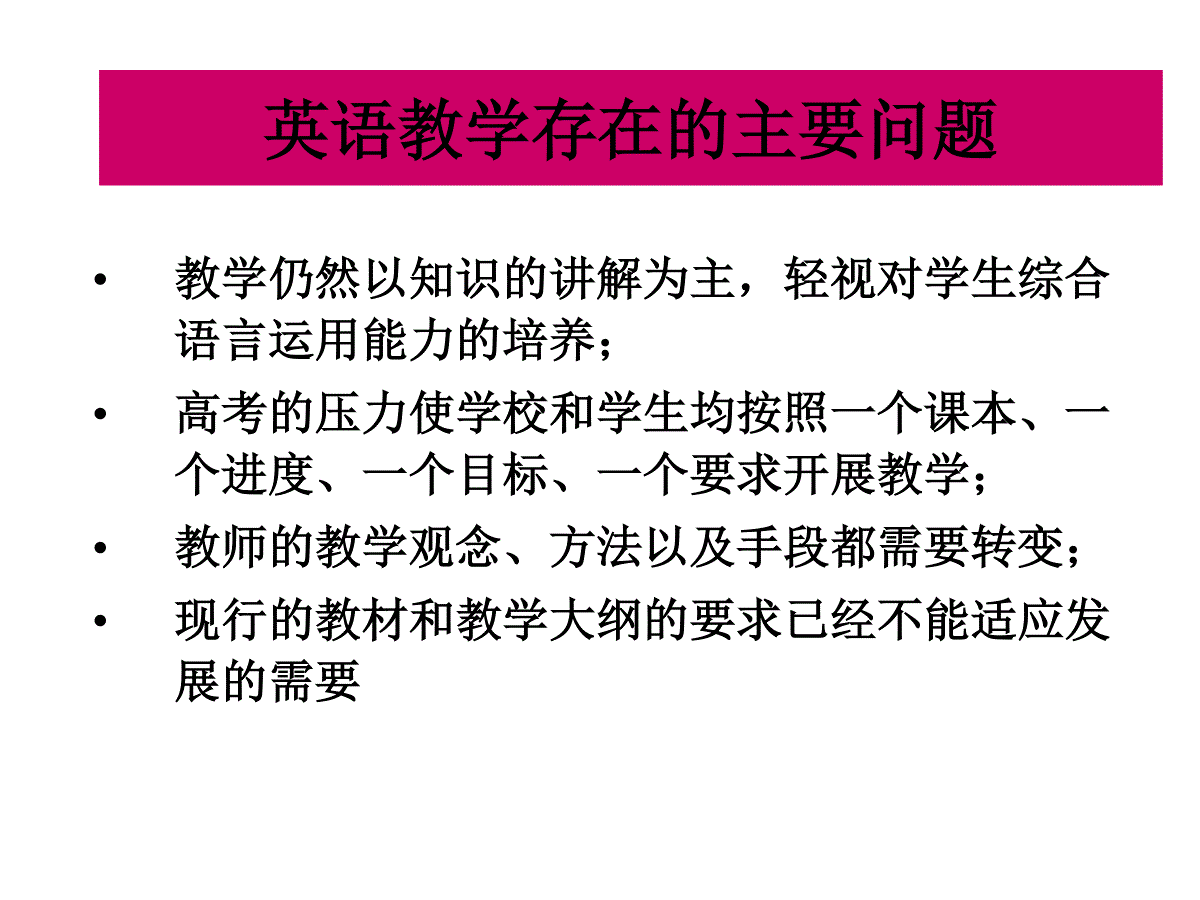当前位置:首页 > 商业/管理/HR > 经营企划 > 国际外语教学改革的发展趋势
国际外语教学改革的发展趋势•以满足人的发展需求为目标,强调对语言运用能力培养。•外语课程普遍采用按能力分级的方式,制定各个级别的能力标准。•课程设置采用必修和选修相结合的方式。•课程内容强调外语学习与其他学科的相互渗透。•教学方法强调以学生为主体,重视学生参与,发展多方面的能力。•重视外语教育对情感、态度、价值观等基本素养的培养•教学资源的扩展促进教学模式的改进,使个性化学习方式得以实现。•评价改革形成潮流,重视对学生学习过程的评价。•教学仍然以知识的讲解为主,轻视对学生综合语言运用能力的培养;•高考的压力使学校和学生均按照一个课本、一个进度、一个目标、一个要求开展教学;•教师的教学观念、方法以及手段都需要转变;•现行的教材和教学大纲的要求已经不能适应发展的需要英语教学存在的主要问题英语课程设计的基本理念1.重视共同基础,构建发展平台2.提供多样选择,适应个性需求3.优化学习方式,提高自主能力4.关注学生情感,提高人文素养5.完善评价体系,促进学生发展综合语言运用能力情感态度学习策略文化意识语言技能语言知识国际视野祖国意识合作精神自信意志兴趣动机交际策略资源策略调控策略认知策略跨文化交际文化理解文化知识话题功能语法词汇语音写读说听课程目标英语课程的教学重点发展学生•用英语进行交流的能力;•用英语获取信息、处理信息的能力;•用英语进行思维的能力。改进教学方法,落实新课程目标词汇教学语法教学听的教学说的教学阅读教学写的教学综合技能学习者培训词汇教学-什么是词汇学习?(1)knowingawordmeansknowingitspronunciationandstress;(2)knowingawordmeansknowingitsspellingandgrammaticalproperties;(3)knowingawordmeansknowingitsmeaning;(4)knowingawordmeansknowinghowandwhentouseittoexpresstheintendedmeaning(5)Knowingawordoftenmeansknowingmorethanjustoneword(e.g.giveup;babysitter,teacher,upsanddowns)(6)Knowingawordmeansknowingitscollocations(e.g.see,look,andwatch;heavyrainbutnotheavywind)Receptiveandproductivevocabulary•Receptive/passivevocabulary-wordsthatoneisabletorecognizeandcomprehendinreadingorlisteningbutunabletousethoseautomaticallyinspeakingorwriting.•Productive/activevocabulary-wordsthatoneisnotonlyabletorecognizebutalsoabletouseinspeechandwritingareconsideredone’sproductive/activevocabulary.•Atbeginnerlevel,mostnewwordslearnedbystudentsusuallyhaveimmediatepracticaluse,hencetheyquicklybecometheproductivevocabulary.However,asstudentslearnmoreandmorewords,theywillfindthatsomewordstheyareabletouseforspeakingandwritingandsomeareonlyrecognizablewhenencounteredinreading.Also,therearesomewordsthatafterbeingencounteredmoreandmoretimesgraduallyentersfromone’sreceptivetoone’sproductiveWaysofpresentingvocabulary•Trytoprovideavisualorphysicaldemonstrationwheneverpossible,usingpictures,photos,videoclips,mimeorgesturestoshowmeaning.•Provideaverbalcontexttodemonstratemeaning.Thenaskstudentstotellthemeaningfirstbeforeitisofferedbytheteacher.•Usesynonymsorantonymstoexplainmeanings•Uselexicalsetsorhyponymstoshowrelationsofwordsandtheirmeanings,e.g.cook:fry,boil,bake,grill,etc.•Translateandexemplify,especiallywithtechnicalwordsorwordswithabstractmeaning.•Usewordformationrulesandcommonaffixestobuildnewlexicalknowledgeonwhatisalreadyknown.•Teachvocabularyinchunks.Chunksrefertoagroupofwordsthatgotogethertoformmeaning.Itisalsoreferredtoas‘pre-fabricatedformulaicitems’(Lewis,2002:121).•Thinkaboutthecontextinreallifewherethewordmightbeused.Relatenewlylearnedlanguagetostudents’reallifetopromotehighmotivation.•Thinkaboutprovidingdifferentcontextforintroducingnewwords.Developingvocabularylearningstrategies•Reviewregularly•Guessmeaningfromcontext•OrganizingvocabularyeffectivelyUselearnedvocabulary•Usedictionary•Createvocabularynotebook语法教学Grammarpresentation•Deductivemethod•Inductivemethod•GuideddiscoverymethodAbouttheteachingoflistening听的目的-tomaintainorbuildsocialrelationships.-toobtainandexchangeinformation.关注听的过程Theskillsoflisteningareoftenthoughtofaspassiveskills.Thisisnottrue.Peoplemustdomanythingstoprocessinformationthattheyarereceiving.Firsttheyhavetohearwhatisbeingsaid,thentheyhavetopayattention,andconstructameaningfulmessageintheirmindbyrelatingwhattheyheartowhattheyalreadyknow.Weallknowthatitispossibletohearpeopletalkingwithoutpayingattention.Wealsoknowthatifwedonothaveenoughpreviousknowledgeofwhatisbeingsaid,itismoredifficulttomakesenseofwhatissaid.So,listeningisasactiveaskillasspeaking.Itissimplymoredifficultforteacherstojudgehowwellthestudentsarecomprehendingthemessages.Soitisveryimportanttodesigntaskstheperformanceofwhichshowhowwellthestudentshavecomprehendedthelisteningmaterial.Principlesforteachinglistening(1)Thelisteningactivitymusthaveareal,communicativepurpose.(2)Theactivitymustuseauthenticlanguagewithoutsignificantlyslowerorsimplerspeechthanwouldnormallybeusedineverydaylife.(3)Thelisteningtextmustoffercontentthatispersonallyinterestingandmotivatingtolearners.(4)Thelisteningactivitymustoffermanycluestomeaning,justasinreal-lifelistening.(5)Whenpossible,thewholelisteningtextshouldbegivenfirst,andthenitshouldbedividedintopartsthatcanberepeated.Attheend,thewholetextshouldbegivenagain,andlearnersshouldhavetheopportunitytodiscusswhattheyhaveheard.(6)Thelisteningactivitymustrequirelistenerstorespondinsomemeaningfulfashion,eitherindividuallyorinsmallgroupsorpairs.(7)Thetextofthelisteningactivitymustbetypicalforitsownspeechtype;thatis,aninformalconversationmusthaveshort,redundant,rapidchunksofspeech,whilealecturemustbemoreformalizedandorderly.(8)Theclassroomclimatesurroundingthelisteningactivitymustbenon-threateningandpositive,andsimpleaffectivestrategiesshouldbeusedtoreduceanxietyifitispresentbeforeorduringthelisteningactivity.Threestagesoflistening•Pre-listeningtasksshouldbeusedtostimulatetheappropriatebackgroundknowledge,providelearnerswithapurposeofthelisteningactivityandpreparethemwiththelanguageneededforunderstandingthemessage(e.g.discussingthetopic,brainstormin





 三七文档所有资源均是用户自行上传分享,仅供网友学习交流,未经上传用户书面授权,请勿作他用。
三七文档所有资源均是用户自行上传分享,仅供网友学习交流,未经上传用户书面授权,请勿作他用。
本文标题:国际外语教学改革的发展趋势
链接地址:https://www.777doc.com/doc-2597047 .html